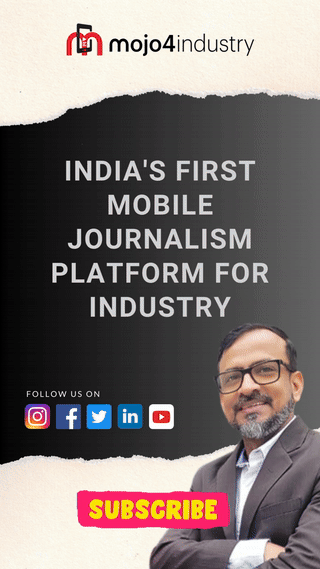Industry 4.0 Trends: Shaping the Future of Manufacturing | Digital Dialogue
Industry 4.0, often referred to as the fourth industrial revolution, is a paradigm shift that is redefining the way industries operate and innovate. Explore the interactive session on Industry 4.0 Trends: Shaping the Future of Manufacturing with Rajesh Hari, Sales Manager- Bangalore Region, ifm electronic India, in conversation with Subhajit Roy.
Delve into the latest advancements and transformative technologies influencing the manufacturing sector, and gain insights into how Industry 4.0 is reshaping operational landscapes, streamlining production processes, and fostering competitiveness in the global marketplace.
Rajesh Hari, Sales Manager- Bangalore Region, ifm electronic India said: We are a global company based in Germany and are recognized as leaders in sensors and evaluation systems worldwide. Our focus is on Industry 4.0, and over the past five to six years, our product development has been oriented towards this concept. We have integrated components from the shop floor to the machine level, established gateways, and introduced our own servers and software.
In the context of Industry 4.0, Overall Equipment Efficiency (OEE) is a well-known metric. It measures how effectively a manufacturing process utilizes its full potential. OEE is calculated based on three factors: machine availability, machine performance, and the quality of the end product.
Equipment breakdowns, and unplanned events causing the machine to stop, lead to production loss. These breakdowns can result from factors such as a lack of operating materials or machine malfunctions. The second factor affecting OEE is availability, which includes setup and adjustments. Small changeovers, tool changes, and cleaning activities can lead to production loss if not monitored correctly.
Regarding machine performance, it can be categorized into idling and short stops. Short stops occur briefly and can be caused by material jams, misfeeds, incorrect mountings, misalignments, sensor issues, design problems, and cleaning processes. Another aspect is reduced speed, where the equipment operates slower than expected, possibly due to worn-out bearings or other issues. The skill of the operator also influences machine performance.
These factors impact the quality of the product produced by the equipment. Quality issues result in losses because the defective parts cannot be reworked. Quality is measured by parameters such as startup scrap, which involves trial and error during warm-up cycles. The testing and trials can lead to the production of defective parts, resulting in financial losses.
We calculate the OEE based on three factors: availability, performance, and quality. With values of 75%, 80%, and 95%, we obtain the average OEE of the equipment, reflecting various issues in machines, both small and large.
Globally, special purpose machines typically have an OEE of 25%, general purpose machines have an OEE of 65%, and Toyota’s main production facility operates with an OEE of 85%. These percentages categorize and indicate the performance of the machines.
Moving on to the next topic, Industry 4.0, the fundamental requirement is sensors on a machine that conveys whether things are correct or not. This basic level of automation, previously discussed, is now considered the foundation of Industry 4.0. These sensors, once known as digital or analog, are now referred to as intelligent sensors. The sensor industry has evolved, emphasizing intelligence over complexity, ensuring simplicity in usage and readiness to provide data.
This leads to the question of how to capture this data, which brings us to IoT. In the pre-Industry 4.0 era, communication between sensors and the PLC or controller involved basic signaling such as yes or no, or a current signal based on activity or process data. Data was captured on the controller through respective input cards, limiting interaction between the PLC and field instruments.
Now, things have changed. Sensors have evolved, and even a simple digital sensor can provide data beyond a binary yes or no response. For instance, consider a proximity sensor on a conveyor. It not only indicates the presence of an object but also specifies the range at which the object is located.
Let’s take an example: on a conveyor where an object moves at a specific distance. If there’s a mechanical mounting issue or improper loading on the conveyor, the object may come too close to the sensor. In the case of a mounting issue, the sensor might move toward the object, increasing the risk of a collision and potential sensor malfunction. This malfunction could lead to a disruption in the production line, causing it to stop. Monitoring the sensor’s readings is crucial. If the sensor indicates values outside the normal range, it signals a potential issue. Addressing this anomaly through maintenance activities can prevent unplanned breakdowns and ensure continuous operation.
Now, let’s discuss what hinders the swift adoption of technology. We refer to this as the 3C—Cost, Change, and Compatibility. Cost is a significant consideration in implementing Industry 4.0 and IoT. Companies ponder on the investment required and the return on investment (ROI). The questions revolve around the feasibility of the investment and the anticipated benefits.
The second challenge is change. Existing machines are in operation, and these process equipment are often not easily modified. Altering them may lead to downtime, resulting in production loss and financial setbacks. Overcoming this challenge, our company introduces a solution known as an IO-link Gateway or an IO-link Master. It acts as a field-mounted input card with IO-link capability. This means connecting the sensor on the machine to this master using a standard cable. The master captures specific data from the sensor, transmitting it to the controller, PLC, and even further to SQL servers or Cloud servers through an IoT port. This approach helps bridge the gap without requiring extensive modifications to existing machinery.
Traditional sensors provide binary data, offering a simple yes or no response. However, with IO-link-enabled sensors, they can deliver more nuanced information. For instance, a pressure sensor can provide data on both pressure and temperature, and a flow sensor can offer information on flow and temperature. These sensors allow access to various parameters, enabling adjustments to settings and set points directly from the PLC.
Additionally, IO-link brings diagnostic capabilities, providing insights into the monitored process parameters, which isn’t possible with regular sensors. Importantly, IO-link is not proprietary. Furthermore, these sensors come equipped with an IoT port, featuring two distinct IP IDs—one for field bus communication to the PLC and another for IoT. This dual functionality allows the sensor to transmit data in formats such as JSON, MQTT, or HTTP. This means you can either retrieve data through the PLC or directly collect information from these field-mounted instruments to the server.
It’s worth noting that the use of IO-link is not exclusive to ifm sensors; it can be integrated with sensors from any manufacturer, offering flexibility and compatibility.
Now, introducing IO-link Wireless—a notable development for situations where traditional wiring is impractical. In areas such as hard-to-reach spaces, conveyor turntables, or locations with intricate cable paths, the wireless solution becomes essential.
Once we have identified issues in the machinery and gathered relevant data, the next step is managing this information. ifm offers an IoT platform, Moneo, which acts as digitalization software. This software seamlessly accepts data from the IO-link Master or directly from the PLC. Why PLC? Because it accommodates submission data monitoring, making it versatile for various solutions. The platform is customizable and suitable for both small-scale and large-scale systems. Whether you are running a modest workshop or venturing into Industry 4.0, it adapts based on the number of points you want to monitor—be it 10 inputs or as many as 2,500 inputs.
The data collected by the application is transmitted to the software, where features like alarm generation and notifications for low or high values can be configured. The dashboard provides a clear representation of actual values, presenting information in a format akin to a Scara-type display.






